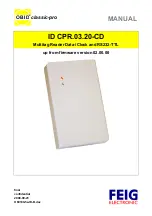
ACR128 Dual Interface Smart Card Reader
5.0 PICC Interface Description
5.1 ATR Generation
If the reader detects a PICC, an ATR will be sent to the PCSC driver for identifying the PICC.
5.1.1
ATR format for ISO 14443 Part 3 PICCs.
Table 7: ISO 14443 Part 3 ATR Format
Byte
Value
(Hex)
Designation Description
0 3B
Initial
Header
1 8N
T0
Higher nibble 8 means there are no TA1, TB1 and
TC1. Only TD1 follows.
Lower nibble N is the number of historical bytes
(HistByte 0 to HistByte N-1)
2 80
TD1
Higher nibble 8 means there are no TA2, TB2 and
TC2. Only TD2 follows.
Lower nibble 0 means T = 0
3 01
TD2
Higher nibble 0 means no TA3, TB3, TC3 and TD3
follow.
Lower nibble 1 means T = 1
80 T1
Category indicator byte 80 means a status indicator
may be present in an optional COMPACT-TLV data
object
4F
Application identifier Presence Indicator
0C Length
RID
Registered Application Provider Identifier (RID) #
A0 00 00 03 06
SS
Byte for standard
C0 C1
Tk
Bytes for card name
4
To
3+N
00 00 00 00
RFU
RFU # 00 00 00 00
4+N
UU
TCK
Exclusive-ORing of all the bytes T0 to Tk
Example:
ATR for MiFare 1K = [3B 8F 80 01 80 4F 0C A0 00 00 03 06 03 00 01 00 00 00 00 6A]
ATR
Initial
Header
T0 TD1 TD2 T1 Tk Length RID
Standard Card
Name
RFU TCK
3B
8F
80 01 80
4F
0C
A0
00
00
03 06
03
00 01
00 00 00
00
6A
Where:
Length (YY)
=
0C
RID
= A0 00 00 03 06 (PC/SC Workgroup)
Standard (SS)
= 03 (ISO14443A, Part 3)
Card Name (C0 ... C1)
= [00 01] (MIFare 1K)
[00 02] (Mifare 4K)
[00 03] (Mifare Ultralight)
FF [SAK] (Undefined)
[FF 0] (Mifare Mini)
Page
12 of 36
ACR128 API
Version 1.7 May 2008













































